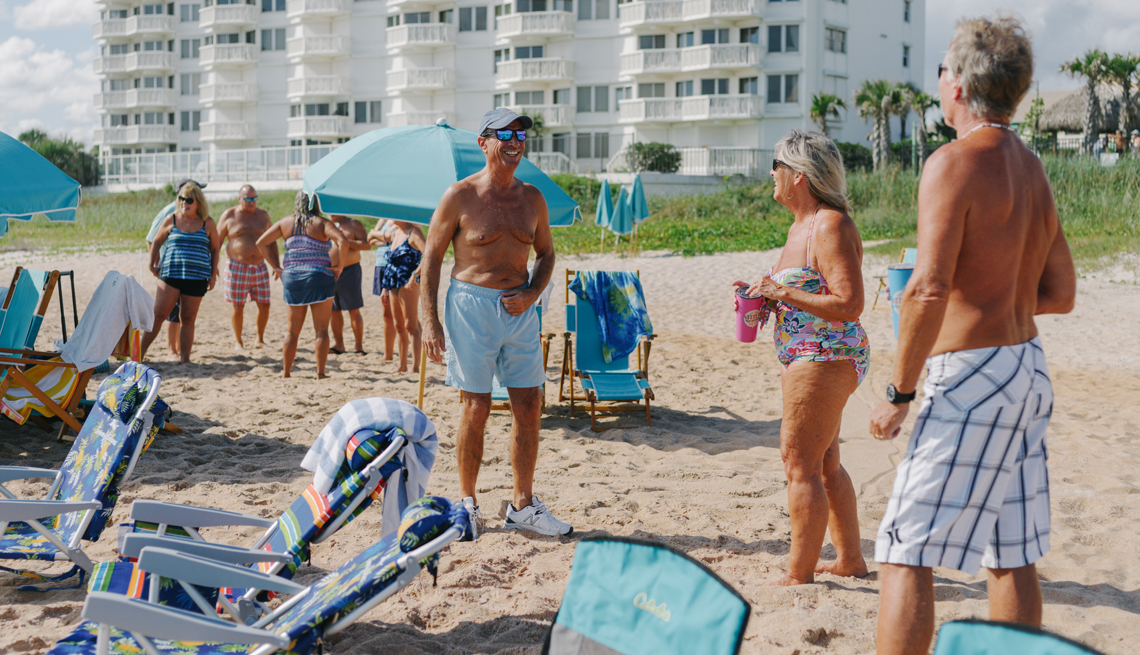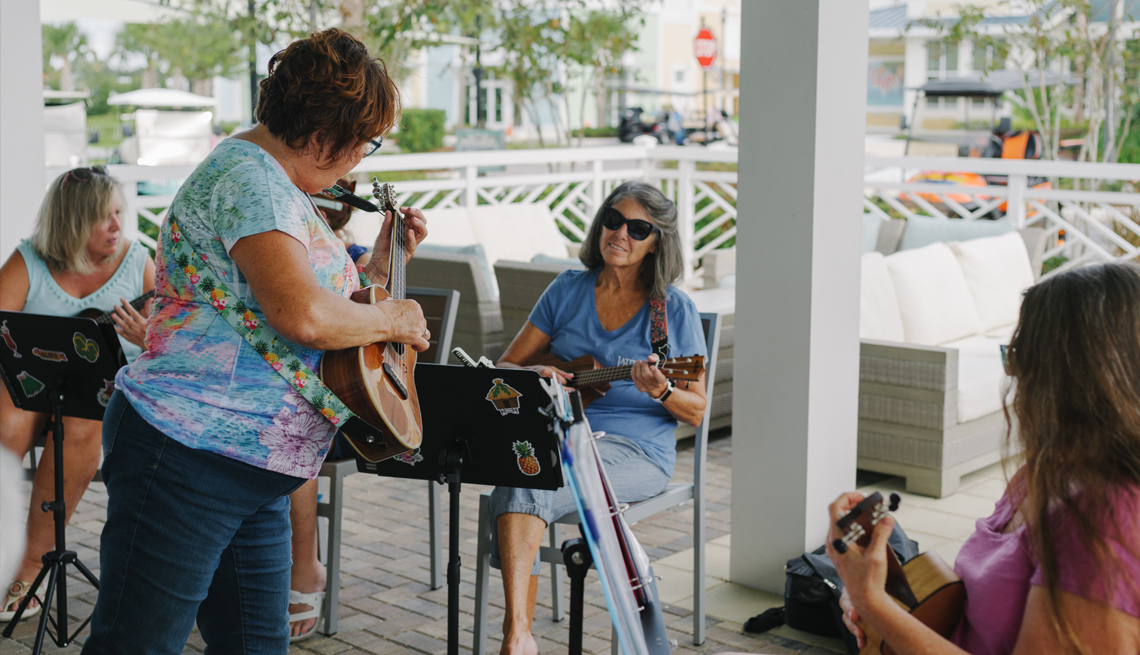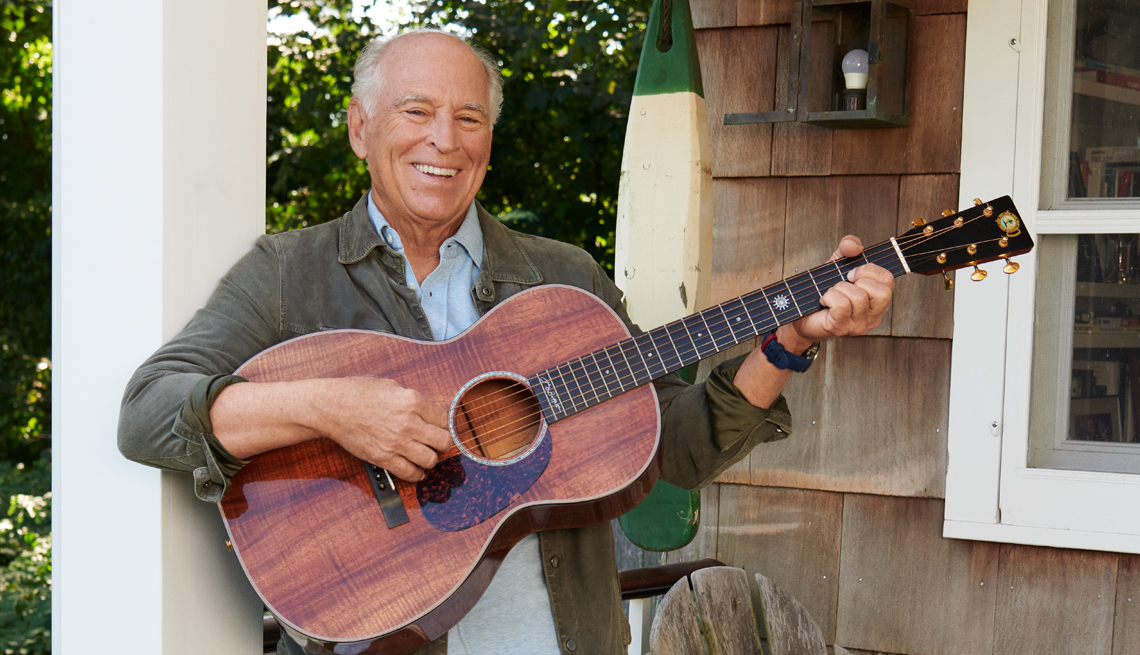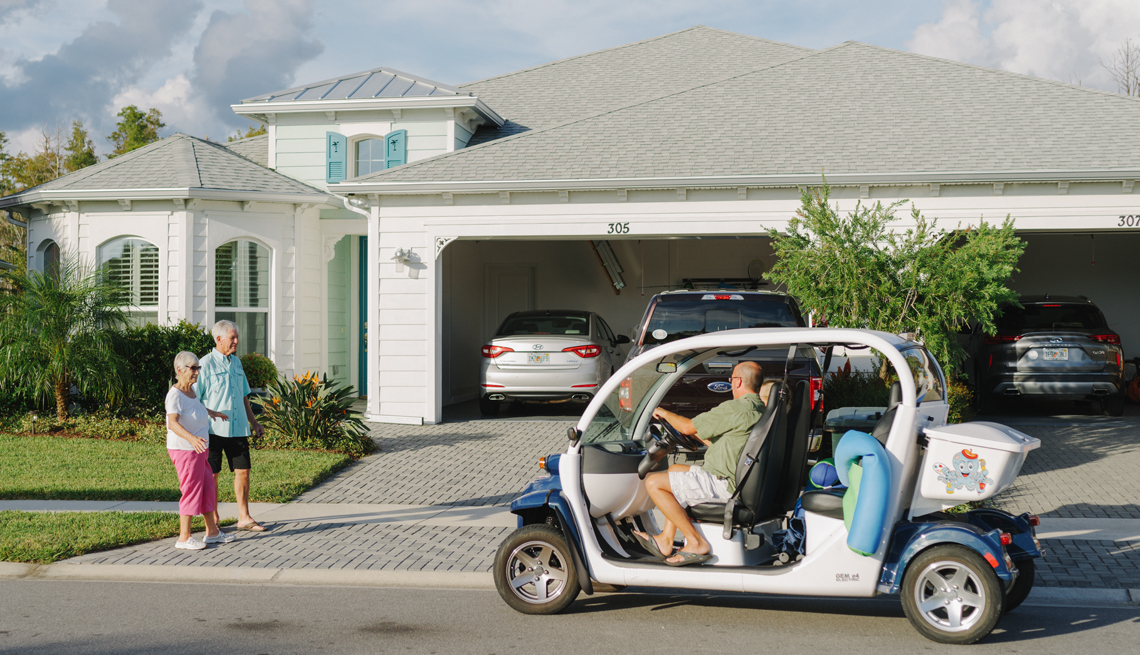New Retirement Village Attracts Jimmy Buffett Fans
Devotees and residents discuss the relaxed vibe of a laid-back lifestyle with amenities
Is it us, or does Latitude Margaritaville, a new retirement village that’s located in Daytona Beach, Florida, sound suspiciously close to a couple of Jimmy Buffett songs? Turns out this pastel-hued development for boomers is as near as anyone can get to living inside Buffett’s brain.
You can eat a Cheeseburger in Paradise (after his 1978 tribute to a favorite food) at the Latitude Bar & Chill or exercise your pup at Barkaritaville dog park. The place’s tidy pink-and-blue clapboard homes mimic the singer-songwriter’s candy-colored album covers. When I dropped in last July, I found myself starting to act like a character in one of those songs, day drinking at a tequila-fueled cocktail party and pleasantly wasting away the next few hours in an airy beach house, which I’d rented for a couple of days to get a taste of life here.
But to attain full immersion, several residents told me, I’d have to get out in the sun and sweat a little. With Florida temperatures topping 90 degrees, I begged off pickleball, tennis or bocce, opting instead for something pool-based: a class in “aqua kickboxing.”
At the Fins Up! Fitness Center, I was confronted with an oceanic expanse of a pool surrounded by palm trees and umbrella-shaded tables. Some 20 fit-looking women in their 70s (and up) bobbed in the water while an energetic instructor in spandex cheered them on poolside.
As I lowered myself into the pool, I hoped I wouldn’t embarrass my pool mates with my vigor and prowess. Our trainer pushed the play button on a boom box and demonstrated rapid-fire moves — side lunges, front kicks, punches, jumping jacks — made maddeningly difficult due to water resistance. Five minutes in, I was gasping for air, muscles burning, my mind screaming: This cannot go on much longer!
It went on, nonstop, for another 40 minutes. Sheer ego compelled me to finish, whereupon I climbed, trembling, from the water. Only then did I notice that my pool mates were not following. They were patiently awaiting the start of the next class: “aqua Zumba.” When I expressed disbelief, they laughed. “Oh, we’ve been doing these routines for months,” one woman said. “We’re used to it.”
It was then that I understood the full scope of the Buffett Vision of Retirement Life: a vacation-style, every-day-is-Saturday vibe, mixed with some vigorous activity and community involvement to keep brain and body in working order — and hold melancholy musings at bay.
The notion of an age-restricted retirement community was born in the American Southwest. After Sun City, Arizona — developer Del Webb’s first community for people 55 and older — opened in 1960, it was such an explosive hit that it landed Webb on the cover of Time magazine. Over-55 communities have proliferated in America ever since; today there are Del Webb Active Adult Communities in 19 states, and countless competitors, including seven Leisure World locations. Recent years have seen the introduction of appealing new alternatives such as multigenerational villages and farm-to-table elder communities. Latitude Margaritaville circa 2021 has familiar echoes of Webb’s relaxation-based vision circa 1960 (if you throw in tequila, salt and medicinal weed).
Still, Buffett’s version of post-work paradise marks a departure from previous iterations of the idea, including the current big kahuna of retirement centers: The Villages, the vast central-Florida 55-plus community that boasts a mind-boggling 693 holes of golf. Started in the 1980s, The Villages has a population of more than 130,000 and is a prime stopover for political campaigns.
Latitude Margaritaville, by contrast, appears to be for boomers who share collective memories — not of Jack Nicklaus or college political clubs, but of dancing at stadium shows with a bunch of strangers-turned-comrades. Residents seem to purposefully avoid sources of interpersonal friction: During the 2020 campaign, they even voted to remove all election signs from their lawns.
Latitude Margaritaville positions itself as a younger, hipper place to retire, with marketing materials that deploy the ubiquitous slogan, “Growing older but not up.” That’s the title of a 1981 Buffett song, and it’s Buffett himself who is the development’s main selling point. As a self-described living symbol of the boomer generation, he is a perfect tout for a community tailor-made for the aging youthquake whose music and movies and books and fashions dominated the world for decades. For Buffett, it’s a savvy brand extension: His Margaritaville resorts, restaurants, casinos and merchandise have already made him a half-billionaire.
And indeed, since the first homes went on sale at Daytona Beach in November 2017, Buffett’s company has sold more than $600 million worth of units across three locations: the original one, Daytona Beach (which recently upped its capacity to 3,900 homes); Hilton Head, South Carolina; and Panama City Beach, Florida, where Margaritaville Watersound, zoned to include up to 170,000 homes, will be the largest “active living” retirement community in the United States, if fully built out. But that’s still a big if.
No one was more surprised at the notion of Buffett opening retirement communities than the singer himself. “When they approached me about the idea,” he recalls, "I said, ‘Really? They want to live in Margaritaville?’ ”
A week after my trip to Daytona Beach, I was meeting with Buffett in his light-filled, guitar-crammed home studio in Sag Harbor, Long Island. He was dressed in Hawaiian shirt and shorts, and sandals that he kicked off as we settled onto a scuffed leather couch. He’s 74 now and graying, but his committed exercise and diet regimen keeps him fit. Indeed, he seems to have blossomed with age, the bland, blond suburban dad of the 1980s and ’90s giving over to the current rascal rocker.
Buffett considers himself blessed on many counts. Married to the same woman, Jane Slagsvol, since 1977, he is close to their three grown children (two daughters and a son). Until the COVID shutdown, he was one of the most successful live acts on the planet. He has, in the last year and a half, recorded and released two albums, including Life on the Flip Side, his first LP of originals in seven years, which debuted at number 1 on Billboard’s country album chart. Still flying his four private planes, captaining his custom-built fishing boat, foil surfing, dining with friends like Paul McCartney and Warren Buffett, and bopping among homes in St. Barts, New York and Los Angeles, among other places, he has every reason to be happy.
Conspicuous in the list of Buffett’s recent achievements — which also include best-selling books and a SiriusXM radio station with 9 million weekly listeners — are major undertakings such as a $370 million resort in Times Square that opened last July and a show, Escape to Margaritaville, that played on Broadway in 2018 and recently resumed a national tour. Such projects make it clear that Buffett is nowhere close to retiring. “They’re going to have to drag me off that stage or out of the cockpit,” he says, laughing. “I want to be the poster child for the person who could retire but doesn’t.”
The utterance might seem a major PR gaffe for a newly minted retirement mogul, but Buffett knows that his fans don’t expect him to live as they do. His style is aspirational; he has been a lifestyle influencer since before the term existed. One of Buffett’s major aims in building retirement havens, he says, is so that his fans can finally experience the life he sings about. “Lot of people worked harder than they played in their real lives,” he says. “This is their time to play.”
A little history for those who might not know him: Buffett first entered the public mind as the Man on Permanent Vacation in the 1970s, after he moved from Nashville to Key West, Florida, in his mid-20s, in full flight from a broken first marriage and a debut LP that bombed. Under the influence of Key West’s white sand beaches, palm trees and ocean breezes, he stopped writing despairing folk songs and started to express his fundamentally positive worldview in a series of albums: A White Sport Coat and a Pink Crustacean (1973), Living and Dying in 3/4 Time (1974) and A1A (1974). Though none were chart-toppers, they sold well enough to keep Buffett on tour, filling midsize venues, until 1977, when he released a song about a man gently stewing in the sweet despair of a breakup. He claims it took 20 minutes to write “Margaritaville,” which his pal Tom Freston, the former CEO of MTV Networks and Viacom, says may be “the most valuable song” ever written, right up there with “White Christmas.”
AARP Membership -Join AARP for just $12 for your first year when you enroll in automatic renewal
Join today and save 25% off the standard annual rate. Get instant access to discounts, programs, services, and the information you need to benefit every area of your life.
Indeed, now that the song is the basis for a major branding operation that does more than $1 billion in annual sales, Buffett can sound a little defensive about it. He insists the song is not the debauched lament to which revisionists have tried to reduce it. “I’m a good Catholic,” Buffett says, semi-jokingly. “At the end of the song, I blame myself. I take responsibility.”
Thanks to the lilting steel drum hook and Buffett’s soaring chorus, the song became the top-10 hit he had been chasing for a decade. I asked Buffett’s longtime manager, Irving Azoff, how “Margaritaville” changed Buffett.
“Jimmy the person didn’t change,” Azoff says. “But Jimmy the artist changed a lot because he became a headliner, selling out arenas.” Fans started following Buffett’s tour from city to city, like the famous Deadheads who shadowed the Grateful Dead. In 1985, when a bandmate noticed that fans were showing up wearing colorful headgear that made them look like tropical birds, someone dubbed them the Parrot Heads, still the term of art for the most fanatic of Buffett’s fans. They arrive hours, even days, before his concerts to hold boozy tailgate parties.
Despite his popularity on the road, Buffett has never been a favorite of the Grammys, the Rock & Roll Hall of Fame or radio playlists. But if the critics don’t love Buffett, some of his fellow musicians take up the slack. Bob Dylan has called Jimmy Buffett one of the finest songwriters America has ever produced, citing the poignant ballads “He Went to Paris” and “Death of an Unpopular Poet.”
Says Chris Blackwell, the founder of Island Records, which released some of Buffett’s albums, “He’s a great songwriter, there’s no question about that.” His Caribbean-inflected sound belongs to “a genre of his own,” Blackwell adds, but it’s Buffett’s personality that makes his followers so loyal. “He is an incredibly warm, generous person, and that extends to being onstage,” Blackwell says. “People feel it.”
For Buffett, it all began when he noticed that people selling fan T-shirts had spelled his name wrong. He enlisted a Florida buddy to print up some properly spelled shirts, which he sold from a Key West merchandise shop that he opened in 1985. Two years later, the shop, called Margaritaville — by now selling food and drink — was racking up $1 million a year in sales. It dawned on Buffett that he might have the basis for a serious brand, but he also knew he lacked the expertise necessary to take the thing global. So in 1999, he invited a Wall Street friend, John Cohlan, who had worked on major brands including RC Cola and Snapple, to work for him. “I said, ‘I can’t pay you what you get on Wall Street, but we can be partners, and you can come to work in shorts and flip-flops,’ ” Buffett recalls.
Cohlan jumped at it because he had once seen Buffett play in front of 100,000 screaming Parrot Heads. “Most brands are about the product they sell,” Cohlan said from his home office, in Palm Beach, over Zoom, “but this was really something emotional.” And emotion drives a brand.
To illustrate what he means, Cohlan takes me back to 1999, to the origin story of the Margaritaville vision, which Buffett himself dashed off on a borrowed word processor at an ad agency office in New York. “Where is Margaritaville?” he wrote. “It’s in the tropics somewhere between the Port of Indecision and Southeast of Disorder, but no parallels of latitude or longitude mark the spot exactly.… Palm trees provide the camouflage, ocean breezes bring the seaplanes and sailboats, tourists and travelers. Passports are not required.…“Where is Margaritaville? It’s in your mind.”
Not every ’70s-era rock star could launch a billion-dollar branding company without being a sellout. But for Buffett, the turn to business seems natural. As his close friend, Rolling Stone publisher Jann Wenner, recalls, Buffett once left a lavish 70th birthday party in Jamaica in mid-revelry to glad-hand the staff of the local Margaritaville restaurant franchise. “That’s what you should do as a good businessman,” Wenner says. “And he enjoys doing it.”
The skeptical way to frame such moments is to call Buffett a faker, someone who plays at being a laid-back beach bum but who, in reality, never stops working. The truth, though, is that Buffett is a seasoned delegator who manages to have an awful lot of Buffett-style fun. “Jimmy is not writing menus,” as Cohlan puts it.
The idea to expand the Margaritaville brand to include retirement communities had already been percolating when Cohlan learned that a Canadian real estate developer, Minto, had bought up 260 acres of Daytona Beach with plans to build a 55-plus community. It didn’t take Buffett long to see the potential. He knew his original boomer fan base was beginning to retire. Thanks to modern medicine, the youngest boomers, born in 1964, could live another 30, 40 healthy years — and with the money to do so in style, since boomers are sitting on more discretionary savings than any previous generation.
“So what are people doing with that time?” Buffett asks. “Lot of people have a good pension — teachers, firefighters — and they want to live with like-minded people.”
Minto agreed to build the planned community while Margaritaville Holdings LLC branded the place. And when the sales center opened in 2017, hundreds camped out overnight in the parking lot with lawn chairs and blenders, exactly like the Parrot Heads at a tailgate party. Footage shows people crying with excitement after signing a contract for a home.
Latitude Margaritaville is not a budget paradise. New-home base prices range from the mid-$200,000s to the mid-$400,000s or more, which doesn’t include monthly maintenance fees or the cost of outfitting the place with upgraded appliances, cabinets and whatever else. A house listed at $200,000 can cost you an extra $50,000 once the dust settles; then again, the median price of an American home is now $353,000.
A retirement based solely around partying and exercise can seem a little self-absorbed, though — a plan for retreating from the world, rather than contributing to it. I asked Buffett directly: “Is Margaritaville just about that?”
At first, he misunderstood. “I was brought up with the idea of noblesse oblige,” he said, sounding injured. “If you become successful, you give back. I’ve always done that. I’m sure we’re the only band that has a retirement plan. We started Singing for Change, our charitable foundation, 26 years ago. We take a dollar from every ticket we sell.” (The foundation helps people living in poverty become more self-sufficient.)
When I stressed that I was talking about the people who live in his retirement villages, he said, “They kind of follow our lead there.” He mentions a resident he met at the Daytona location in the early days of the COVID pandemic. “She organized all the women, and they made more than 2,000 masks for the hospitals.” He also mentions that there are three or four Jimmy Buffett cover bands made up of residents, and that one of them played a benefit that raised $7,000 for a fellow resident’s cancer treatments.
Still, Buffett likes to say that his entire Margaritaville empire — hotels, restaurants, retirement villages and indeed, his entire musical career — is based on escapism.
“It’s vital to have fun in your life,” he says. “That little layer of escapism that we provide, that little layer of humanity, is what keeps us from going back and being tribal.” With its rock ’n’ roll camaraderie and ’60s-inflected sense of community, Latitude Margaritaville promises a certain sunburned stripe of boomer a retirement designed just for them. Even if the pursuit of fun is hardly an innovation, it remains a powerful lure, Buffett says. “Take fun away, take escapism away, take caring about other people away, and you’re right back in the cave.”
Journalist John Colapinto is a longtime contributor to The New Yorker and Rolling Stone and author of As Nature Made Him and This Is the Voice. He profiled Tony Bennett in the February/March 2021 issue.





